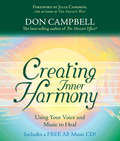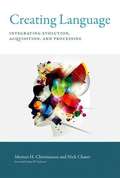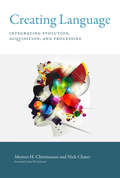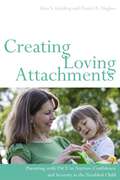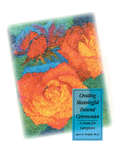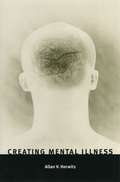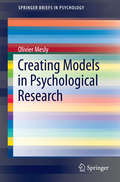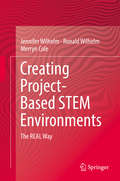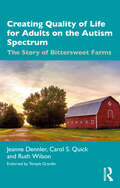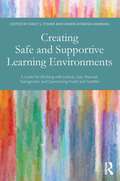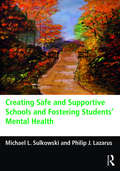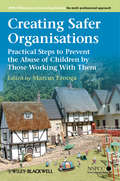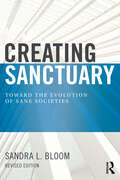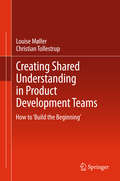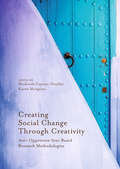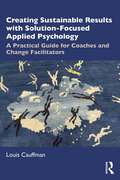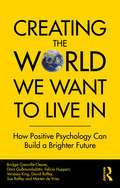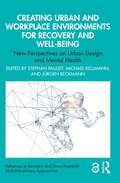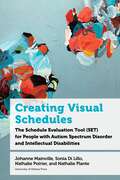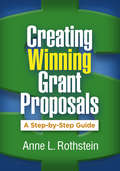- Table View
- List View
Creating Inner Harmony: Using Your Voice And Music To Heal
by Don CampbellWhether we sing, hum, or just inwardly "Ooh" and "Aah," our voices are ideal for expressing emotions, releasing stress, awakening energy or just exploring the world of creativity. This book is a five-day journey into the powerful inner world of vibration. Each chapter is focused on a simple sound and a clear image that will bring you into harmony. The accompanying CD consists of beautiful music that allows you to explore the creative aspects of your voice, emotions, and mental clarity. Simply by humming and toning, you will sense in just a few minutes how to vitalize your mind or calm your stress. Listening, visualizing, and making the simplest of sounds will provide you with new tools for creativity and health
Creating Language: Integrating Evolution, Acquisition, and Processing
by Nick Chater Peter W. Culicover Morten H. ChristiansenLanguage is a hallmark of the human species; the flexibility and unbounded expressivity of our linguistic abilities is unique in the biological world. In this book, Morten Christiansen and Nick Chater argue that to understand this astonishing phenomenon, we must consider how language is created: moment by moment, in the generation and understanding of individual utterances; year by year, as new language learners acquire language skills; and generation by generation, as languages change, split, and fuse through the processes of cultural evolution. Christiansen and Chater propose a revolutionary new framework for understanding the evolution, acquisition, and processing of language, offering an integrated theory of how language creation is intertwined across these multiple timescales.Christiansen and Chater argue that mainstream generative approaches to language do not provide compelling accounts of language evolution, acquisition, and processing. Their own account draws on important developments from across the language sciences, including statistical natural language processing, learnability theory, computational modeling, and psycholinguistic experiments with children and adults. Christiansen and Chater also consider some of the major implications of their theoretical approach for our understanding of how language works, offering alternative accounts of specific aspects of language, including the structure of the vocabulary, the importance of experience in language processing, and the nature of recursive linguistic structure.
Creating Language: Integrating Evolution, Acquisition, and Processing
by Nick Chater Morten H. ChristiansenA work that reveals the profound links between the evolution, acquisition, and processing of language, and proposes a new integrative framework for the language sciences.Language is a hallmark of the human species; the flexibility and unbounded expressivity of our linguistic abilities is unique in the biological world. In this book, Morten Christiansen and Nick Chater argue that to understand this astonishing phenomenon, we must consider how language is created: moment by moment, in the generation and understanding of individual utterances; year by year, as new language learners acquire language skills; and generation by generation, as languages change, split, and fuse through the processes of cultural evolution. Christiansen and Chater propose a revolutionary new framework for understanding the evolution, acquisition, and processing of language, offering an integrated theory of how language creation is intertwined across these multiple timescales.Christiansen and Chater argue that mainstream generative approaches to language do not provide compelling accounts of language evolution, acquisition, and processing. Their own account draws on important developments from across the language sciences, including statistical natural language processing, learnability theory, computational modeling, and psycholinguistic experiments with children and adults. Christiansen and Chater also consider some of the major implications of their theoretical approach for our understanding of how language works, offering alternative accounts of specific aspects of language, including the structure of the vocabulary, the importance of experience in language processing, and the nature of recursive linguistic structure.
Creating Loving Attachments: Parenting with PACE to Nurture Confidence and Security in the Troubled Child
by Daniel Hughes Kim GoldingAll children need love, but for troubled children, a loving home is not always enough. Children who have experienced trauma need to be parented in a special way that helps them feel safe and secure, builds attachments and allows them to heal. Playfulness, acceptance, curiosity and empathy (PACE) are four valuable elements of parenting that, combined with love, can help children to feel confident and secure. This book shows why these elements are so important to a child's development, and demonstrates to parents and carers how they can incorporate them into their day-to-day parenting. Real life examples and typical dialogues between parents and children illustrate how this can be done in everyday life, and simple stories highlight the ideas behind each element of PACE. This positive book will help parents and carers understand how parenting with love and PACE is invaluable to a child's development, and will guide them through using this parenting attitude to help their child feel happy, confident and secure.
Creating Meaning in Funerals: How Families and Communities Make Sense of Death
by William G. HoyCreating Meaning in Funerals is a book about the ways in which bereaved families and communities create meaningful ceremonies against a backdrop of what is culturally appropriate, even when their choices might make little economic sense to those outside the culture. The culmination of these customs and practices, this book maintains, is how bereaved individuals, families, and communities are drawn into significant meaning making in early bereavement. Readers will be repeatedly challenged to suspend their own biases, observe the customs and beliefs of others thoughtfully, and provide counseling support and encouragement to bereaved individuals for whom funerals were or were not effective means of coping with their loss.Discussion questions at the end of each chapter make the book useful for educational settings such as funeral service classroom instruction, thanatology classes, and grief counseling courses. Each chapter is also accompanied by its own reference list to make chapters more useful individually.
Creating Meaning in Young Adulthood: The Self-Actualizing Power of Relationships
by Christopher J. KazanjianCreating Meaning in Young Adulthood explores the ways in which young adults are creating meanings in life through their relationships with the world. Chapters synthesize research in the fields of child psychology, counseling, multicultural education, and existential-humanistic psychology to offer readers a contemporary understanding of the greater challenges for growth and development that youth currently face. Using ample case studies, the book also sets forth a resilience-based approach for helping readers facilitate the healing, growth, and enlightenment of young adults.
Creating Meaningful Funeral Ceremonies: A Guide For Families
by Alan WolfeltMore and more people are considering a career in nursing or healthcare, but the thought of undertaking an academic degree at university can be intimidating. Whether you are moving straight from school or college or have been away from education for some time, Getting Ready for your Nursing Degree is essential preparation for anyone considering becoming or about to become a nursing student. It looks at all aspects of university work in a straightforward way and provides advice, examples and activities designed to help you get the most out of classes, research and assessments, from your first lecture right through to sitting exams and learning on placement. Designed with nursing students in mind, this small but perfectly formed guide is tailored to help you develop the skills you will need not only for your course but for your career and lifelong learning as a registered healthcare practitioner.
Creating Mental Illness
by Allan V. HorwitzIn this surprising book, Allan V. Horwitz argues that our current conceptions of mental illness as a disease fit only a small number of serious psychological conditions and that most conditions currently regarded as mental illness are cultural constructions, normal reactions to stressful social circumstances, or simply forms of deviant behavior.
Creating Mental Illness
by Allan V. HorwitzIn this surprising book, Allan V. Horwitz argues that our current conceptions of mental illness as a disease fit only a small number of serious psychological conditions and that most conditions currently regarded as mental illness are cultural constructions, normal reactions to stressful social circumstances, or simply forms of deviant behavior. "Thought-provoking and important. . .Drawing on and consolidating the ideas of a range of authors, Horwitz challenges the existing use of the term mental illness and the psychiatric ideas and practices on which this usage is based. . . . Horwitz enters this controversial territory with confidence, conviction, and clarity."—Joan Busfield, American Journal of Sociology "Horwitz properly identifies the financial incentives that urge therapists and drug companies to proliferate psychiatric diagnostic categories. He correctly identifies the stranglehold that psychiatric diagnosis has on research funding in mental health. Above all, he provides a sorely needed counterpoint to the most strident advocates of disease-model psychiatry."—Mark Sullivan, Journal of the American Medical Association "Horwitz makes at least two major contributions to our understanding of mental disorders. First, he eloquently draws on evidence from the biological and social sciences to create a balanced, integrative approach to the study of mental disorders. Second, in accomplishing the first contribution, he provides a fascinating history of the study and treatment of mental disorders. . . from early asylum work to the rise of modern biological psychiatry."—Debra Umberson, Quarterly Review of Biology
Creating Models in Psychological Research (SpringerBriefs in Psychology)
by Olivier MeslyThis concise reference serves as a companion to traditional research texts by focusing on such essentials as model construction, robust methodologies and defending a compelling hypothesis. Designed to wean Master's and doctorate-level students as well as new researchers from their comfort zones, the book challenges readers to engage in multi-method approaches to answering multidisciplinary questions. The result is a step-by-step framework for producing well-organized, credible papers based on rigorous, error-free data. The text begins with a brief grounding in the intellectual attitude and logical stance that underlie good research and how they relate to steps such as refining a topic, creating workable models and building the right amount of complexity. Accessible examples from psychology and business help readers grasp the fine points of observations, interviewing, simulations, interpreting and finalizing data and presenting results. Fleshed out with figures, tables, key terms, tips, and questions, this book acts as both a friendly lecturer and a multilevel reality check.
Creating New Families: Therapeutic Approaches to Fostering, Adoption and Kinship Care (Tavistock Clinic Series)
by Jenny Kenrick Caroline Lindsey Lorraine Tollemache Lionel HersovCreating New Families is intended to reflect the practice of the specialist, multi-disciplinary Fostering and Adoption team in the Child and Family Department of the Tavistock Clinic. The team is firmly rooted in an approach which values inter-disciplinary working for the contribution which the thinking of each discipline makes to the overall endeavour with the child and family. It also places great importance on multi-agency collaboration, especially with social services and education, without which no intervention with this group of children can succeed. The book represents the differing ways in which members contribute to the work of the team, with individual and joint accounts by clinicians of the ways in which their therapeutic practice has evolved and about the theoretical thinking on which it is based.
Creating Project-Based STEM Environments: The REAL Way
by Jennifer Wilhelm Ronald Wilhelm Merryn ColeThis book models project-based environments that are intentionally designed around the United States Common Core State Standards (CCSS, 2010) for Mathematics, the Next Generation Science Standards (NGSS Lead States, 2013) for Science, and the National Educational Technology Standards (ISTE, 2008). The primary purpose of this book is to reveal how middle school STEM classrooms can be purposefully designed for 21st Century learners and provide evidence regarding how situated learning experiences will result in more advanced learning. This Project-Based Instruction (PBI) resource illustrates how to design and implement interdisciplinary project-based units based on the REAL (Realistic Explorations in Astronomical Learning – Unit 1) and CREATES (Chemical Reactions Engineered to Address Thermal Energy Situations – Unit 2). The content of the book details these two PBI units with authentic student work, explanations and research behind each lesson (including misconceptions students might hold regarding STEM content), pre/post research results of unit implementation with over 40 teachers and thousands of students. In addition to these two units, there are chapters describing how to design one’s own research-based PBI units incorporating teacher commentaries regarding strategies, obstacles overcome, and successes as they designed and implemented their PBI units for the first time after learning how to create PBI STEM Environments the “REAL” way.
Creating Quality of Life for Adults on the Autism Spectrum: The Story of Bittersweet Farms
by Ruth Wilson Jeanne Dennler Carol S. QuickCreating Quality of Life for Adults on the Autism Spectrum: The Story of Bittersweet Farms provides an overview of the first farmstead community for adults with autism established in North America. The book also provides a detailed description and evaluation of the intervention model used to promote quality of life for the adults with autism who live as residents at Bittersweet Farms. Through its aim to provide a better understanding of adults with autism spectrum disorder (ASD), the text enables a deeper appreciation of the Bittersweet Farms model, which meets the residential and therapeutic needs of this population that are not often well understood. The book discusses the apprenticeship model used at Bittersweet Farms along with examples of how residents benefit from this approach. The text expands upon its approach through the inclusion of specific guidelines that can be adopted for improved communication and social interaction, managing troublesome behaviors, calming anxieties, and establishing daily routines. These guidelines reflect a positive approach to intervention and are consistent with the quality-of-life emphasis inherent in the Bittersweet model. This book will serve as a seminal work for professionals and paraprofessionals working with people with ASD. It will further be of interest to parents and relatives of people with ASD along with researchers and policymakers concerned about the ASD adult population, and those interested in services for people with ASD.
Creating Safe and Supportive Learning Environments: A Guide for Working With Lesbian, Gay, Bisexual, Transgender, and Questioning Youth and Families
by Emily S. Fisher Karen Komosa-HawkinsThe importance of creating safe spaces for lesbian, gay, bisexual, transgender, and questioning (LGBTQ) students in the school environment cannot be overstated. It is one of the most prominent issues facing school professionals today, and its success has lasting, positive effects on the entire student body. Drawing on the expertise of researchers and practitioners, Creating Safe and Supportive Learning Environments provides a comprehensive examination of the topics most relevant for school professionals. The first section lays out the theoretical foundation and background school professionals need to understand the social and political trends that impact LGBTQ individuals, the development of sexual orientation and gender identity, risk and resilience factors, and the intersection of LGBTQ identity with other aspects of diversity. The second section explores topics critical for the development of safe, supportive school environments, including understanding legal and ethical mandates, training school personnel, addressing bullying and harassment, and developing inclusive classrooms. Special topics related to counseling LGBTQ students, supporting families of LGBTQ students, becoming an ally and advocate in the schools, and connecting with community resources are also covered. CE credit is available to purchasers of this book at www.mensanapublications.com.
Creating Safe and Supportive Schools and Fostering Students’ Mental Health
by Michael L. Sulkowski Philip J. LazarusCreating Safe and Supportive Schools and Fostering Students’ Mental Health provides pre- and in-service educators with the tools they need to prevent, pre-empt, handle, and recover from threats to students’ mental health. School safety and fostering a supportive learning environment have always been issues fundamental to educators. Over the last decade, teachers and administrators have been called on more than ever to cope with bullying, suicide, and violence in their schools. Handling every stage of this diverse set of obstacles can be unwieldy for teachers and administrators alike. Framed with interviews from experts on each of the topics, and including practical and applicable examples, this volume draws together the work of top-tier school psychologists into a text designed to work with existing school structures and curricula to make schools safer. A comprehensive and multi-faceted resource, this book integrates leading research with the well-respected Framework for Safe and Successful Schools to help educators support school safety, crisis management, and students' mental health. Featuring interviews with: Dewey G. Cornell, Frank DeAngelis, Beth Doll, Kevin Dwyer, Katie Eklund, Maurice J. Elias, Michele Gay, Ross W. Greene, Rob Horner, Jane Lazarus, Richard Lieberman, Troy Loker, Melissa A. Louvar-Reeves, Terry Molony, Shamika Patton, Donna Poland, Scott Poland, Eric Rossen, Susan M. Swearer, Ken Trump, and Frank Zenere.
Creating Safer Organisations
by Marcus EroogaAn accessible resource to help those in organisational settings ensure that they have taken all possible steps to safeguard the children and young people they are responsible for.Draws on up to date research with people who have committed sexual offences against children in organisational settings, and new developments in interviewing approachesDetails recent cases to illustrate points about institutional failures in protecting children Highlights the fact that those who sexually offend against children are a diverse and heterogeneous population, and the approaches taken to protect children must address the range of possible risksMakes a firm commitment to the importance of multi-agency and inter-disciplinary collaboration and is relevant in both community and residential settingsOffers clear and practical messages and measures for organisations to act on
Creating Sanctuary: Toward the Evolution of Sane Societies, Revised Edition
by Sandra L BloomCreating Sanctuary is a description of a hospital-based program to treat adults who had been abused as children and the revolutionary knowledge about trauma and adversity that the program was based upon. This book focuses on the biological, psychological, and social aspects of trauma. Fifteen years later, Dr. Sandra Bloom has updated this classic work to include the groundbreaking Adverse Childhood Experiences Study that came out in 1998, information about Epigenetics, and new material about what we know about the brain and violence. This book is for courses in counseling, social work, and clinical psychology on mental health, trauma, and trauma theory.
Creating Shared Understanding in Product Development Teams: How to ‘Build the Beginning’
by Louise Møller Christian TollestrupDevelopment projects that span different disciplines and groups often face problems in establishing a shared understanding of the project's purpose, deliverables, and direction. Creating Shared Understanding in Product Development Teams: How to 'Build the Beginning' uses research-based cases from TC Electronic, The Red Cross, Daimler AG, and Copenhagen Living Lab to demonstrate one approach to this problem complex. It shows how prototyping specific physical artifacts can function as drivers and focal points for creating the much needed shared understanding. Encompassing both the participant's and the facilitator's point of view, Creating Shared Understanding in Product Development Teams: How to 'Build the Beginning' provides both practical examples and theoretical explanation for the process of creating shared understanding. This book provides a toolbox and a practical guide for planning, executing, and facilitating workshops. The result is a clear outline of how to facilitate the creation of physical artifacts that enables and stimulates communication between team members, users, and stakeholders in order to create shared understanding of projects
Creating Social Change Through Creativity: Anti-Oppressive Arts-Based Research Methodologies
by Moshoula Capous-Desyllas Karen MorgaineThis book examines research using anti-oppressive, arts-based methods to promote social change in oppressed and marginalized communities. The contributors discuss literary techniques, performance, visual art, and new media in relation to the co-construction of knowledge and positionality, reflexivity, data representation, community building and engagement, and pedagogy. The contributors to this volume hail from a wide array of disciplines, including sociology, social work, community psychology, anthropology, performing arts, education, medicine, and public health.
Creating Spiritual and Psychological Resilience: Integrating Care in Disaster Relief Work
by Grant H. Brenner Daniel H. Bush Joshua MosesCreating Spiritual and Psychological Resilience explores the interface between spiritual and psychological care in the context of disaster recovery work, drawing upon recent disasters including but not limited to, the experiences of September 11, 2001. Each of the three sections that make up the book are structured around the cycle of disaster response and focus on the relevant phase of disaster recovery work. In each section, selected topics combining spiritual and mental health factors are examined; when possible, sections are co-written by a spiritual care provider and a mental health care provider with appropriate expertise. Existing interdisciplinary collaborations, creative partnerships, gaps in care, and needed interdisciplinary work are identified and addressed, making this book both a useful reference for theory and an invaluable hands-on resource.
Creating Sustainable Results with Solution-Focused Applied Psychology: A Practical Guide for Coaches and Change Facilitators
by Louis CauffmanThis practical, evidence-based guide details how professional practitioners and change facilitators can integrate a solution-focused approach into their daily work and practice. While conventional therapeutic methods centre on the assumption that problems arise due to deficiencies, and therefore focus on diagnosis and subsequent treatment, the solution-focused approach is resource-based and operates on the assumption that human beings always have resources at their disposal to move forward. Free from the burden of detailed problem analysis, the solution-focused approach prioritizes clients’ hope for change in their lives and taps into the opportunities and resources available to bring about such transformation. The solution-focused practitioner is able to design incisive interventions that are flexible enough to adapt to any situation clients might find themselves in, and this book provides a practical formulation that is immediately applicable to all professional fields of applied psychology. Creating Sustainable Results with Solution-Focused Applied Psychology is important reading for therapists and coaches of all schools of thought, as well as anyone who practices as a professional change facilitator, including social workers, mediators, business leaders, and educators.
Creating The World We Want To Live In: How Positive Psychology Can Build a Brighter Future
by Sue Roffey Vanessa King Bridget Grenville-Cleave Dóra Guðmundsdóttir Felicia Huppert David Roffey Marten de VriesThis book is about hope and a call to action to make the world the kind of place we want to live in. Our hope is to provoke conversation, and gently challenge possibly long-held views, beliefs, and ideologies about the way the world works and the people in that world. Written by eminent researchers and experienced practitioners, the book explores the principles that underpin living well, and gives examples of how this can be achieved not just in our own lives, but across communities and the planet we share. Chapters cover the stages of life from childhood to ageing, the foundations of everyday flourishing, including health and relationships, and finally wellbeing in the wider world, addressing issues such as economics, politics and the environment. Based in the scientific evidence of what works and supported by illustrations of good practice, this book is both ambitious and aspirational. The book is designed for a wide audience – anyone seeking to create positive change in the world, their institutions or communities. www.creatingtheworldwewanttolivein.org
Creating Urban and Workplace Environments for Recovery and Well-being: New Perspectives on Urban Design and Mental Health (Advances in Recovery and Stress Research)
by Stephan Pauleit Michael Kellmann Jürgen BeckmannThis essential book offers suggestions for how cities and spaces can be planned and designed to reduce the impact of stress, provide opportunities for recovery, and promote the resilience of individuals in urban communities.Connecting research from different scientific disciplines, the book provides a broader perspective of creating healthy lifestyle in society. It focuses on mental health and well-being by exploring how urban and workplace environments can be created to enhance and promote recovery. Divided into three parts, the book begins by investigating the multi-dimensional challenges of planning and design for stress reduction and recovery in urban areas. Part 2 concentrates on the design of residential and working environments, including commuting between the two, while Part 3 considers how neighbourhoods and entire cities contribute to or obstruct stress reduction, recovery, and well-being. The book concludes by demonstrating how the insights from the book can be implemented in practice to create restorative and inclusive environments. Bringing together leading experts, the book offers an interdisciplinary perspective for increasing well-being in urban developments.The book will be of interest to researchers and practitioners in related fields, including environmental psychologists, urban planners, architects and landscape architects, healthcare staff, and policymakers.
Creating Visual Schedules: The Schedule Evaluation Tool (SET) for People with Autism Spectrum Disorder and Intellectual Disabilities (Education)
by Nathalie Plante Johanne Mainville Sonia Di Lillo Nathalie PoirierLes personnes présentant un trouble du spectre de l’autisme (TSA) ou ayant une déficience intellectuelle (DI) ont généralement un déficit sur le plan des fonctions exécutives et de la mémoire et, par conséquent, ont de la difficulté à s’orienter dans le temps.L’outil Schedule Evaluation Tool (SET) a été élaboré en réponse à ces besoins spécifiques, au moyen d’un horaire visuel. Cet outil aide les personnes qui travaillent auprès d’individus qui présentent un TSA ou une DI à déterminer le type d’horaire le mieux adapté à leurs besoins et à leurs capacités et l’intégrer dans leur milieu de vie, favorisant l’autonomie et une meilleure qualité de vie.Le SET comprend le matériel, les protocoles et le manuel permettant aux intervenantes et intervenants et aux professionnelles et professionnels d’effectuer l’évaluation de l’horaire auprès des enfants, des adolescents et des adultes fréquentant différents milieux de vie tels que les milieux de garde éducatifs, le milieu scolaire, le milieu de stage ou d’emploi et le milieu résidentiel.L’outil d’évaluation SET se divise en quatre parties distinctes. La première se réalise par le biais de manipulation d’objets, de photographies, de pictogrammes et de mots dans un contexte d’évaluation formelle. La deuxième et la troisième parties se déroulent directement dans le milieu de vie où il est nécessaire d’implanter l’horaire. La quatrième et dernière partie est administrée sous forme d’entrevue avec l’intervenant connaissant le mieux la personne visée par l’intervention dans le contexte où l’horaire sera introduit.
Creating Winning Grant Proposals: A Step-by-Step Guide
by Anne L. RothsteinProviding clear-cut steps for producing each section of a competitive grant proposal, this hands-on book is filled with examples from actual RFPs and proposals, practical tools, and writing tips. Prominent educator and successful proposal writer Anne L. Rothstein shares a systematic process created over decades of experience in the field. She details how to: achieve group consensus around a project; identify likely funding sources; establish need; develop objectives; assemble a Master Project Table and other needed tables, figures, and charts; create an effective logic model; prepare an evaluation; put together a budget; tailor the proposal to meet the requirements of funders; and avoid common errors. Purchasers get access to a Web page where they can download and print the book's 14 reproducible templates in a convenient 8 1/2" x 11" size.
